
- •Preface
- •Part IV. Basic Single Equation Analysis
- •Chapter 18. Basic Regression Analysis
- •Equation Objects
- •Specifying an Equation in EViews
- •Estimating an Equation in EViews
- •Equation Output
- •Working with Equations
- •Estimation Problems
- •References
- •Chapter 19. Additional Regression Tools
- •Special Equation Expressions
- •Robust Standard Errors
- •Weighted Least Squares
- •Nonlinear Least Squares
- •Stepwise Least Squares Regression
- •References
- •Chapter 20. Instrumental Variables and GMM
- •Background
- •Two-stage Least Squares
- •Nonlinear Two-stage Least Squares
- •Limited Information Maximum Likelihood and K-Class Estimation
- •Generalized Method of Moments
- •IV Diagnostics and Tests
- •References
- •Chapter 21. Time Series Regression
- •Serial Correlation Theory
- •Testing for Serial Correlation
- •Estimating AR Models
- •ARIMA Theory
- •Estimating ARIMA Models
- •ARMA Equation Diagnostics
- •References
- •Chapter 22. Forecasting from an Equation
- •Forecasting from Equations in EViews
- •An Illustration
- •Forecast Basics
- •Forecasts with Lagged Dependent Variables
- •Forecasting with ARMA Errors
- •Forecasting from Equations with Expressions
- •Forecasting with Nonlinear and PDL Specifications
- •References
- •Chapter 23. Specification and Diagnostic Tests
- •Background
- •Coefficient Diagnostics
- •Residual Diagnostics
- •Stability Diagnostics
- •Applications
- •References
- •Part V. Advanced Single Equation Analysis
- •Chapter 24. ARCH and GARCH Estimation
- •Basic ARCH Specifications
- •Estimating ARCH Models in EViews
- •Working with ARCH Models
- •Additional ARCH Models
- •Examples
- •References
- •Chapter 25. Cointegrating Regression
- •Background
- •Estimating a Cointegrating Regression
- •Testing for Cointegration
- •Working with an Equation
- •References
- •Binary Dependent Variable Models
- •Ordered Dependent Variable Models
- •Censored Regression Models
- •Truncated Regression Models
- •Count Models
- •Technical Notes
- •References
- •Chapter 27. Generalized Linear Models
- •Overview
- •How to Estimate a GLM in EViews
- •Examples
- •Working with a GLM Equation
- •Technical Details
- •References
- •Chapter 28. Quantile Regression
- •Estimating Quantile Regression in EViews
- •Views and Procedures
- •Background
- •References
- •Chapter 29. The Log Likelihood (LogL) Object
- •Overview
- •Specification
- •Estimation
- •LogL Views
- •LogL Procs
- •Troubleshooting
- •Limitations
- •Examples
- •References
- •Part VI. Advanced Univariate Analysis
- •Chapter 30. Univariate Time Series Analysis
- •Unit Root Testing
- •Panel Unit Root Test
- •Variance Ratio Test
- •BDS Independence Test
- •References
- •Part VII. Multiple Equation Analysis
- •Chapter 31. System Estimation
- •Background
- •System Estimation Methods
- •How to Create and Specify a System
- •Working With Systems
- •Technical Discussion
- •References
- •Vector Autoregressions (VARs)
- •Estimating a VAR in EViews
- •VAR Estimation Output
- •Views and Procs of a VAR
- •Structural (Identified) VARs
- •Vector Error Correction (VEC) Models
- •A Note on Version Compatibility
- •References
- •Chapter 33. State Space Models and the Kalman Filter
- •Background
- •Specifying a State Space Model in EViews
- •Working with the State Space
- •Converting from Version 3 Sspace
- •Technical Discussion
- •References
- •Chapter 34. Models
- •Overview
- •An Example Model
- •Building a Model
- •Working with the Model Structure
- •Specifying Scenarios
- •Using Add Factors
- •Solving the Model
- •Working with the Model Data
- •References
- •Part VIII. Panel and Pooled Data
- •Chapter 35. Pooled Time Series, Cross-Section Data
- •The Pool Workfile
- •The Pool Object
- •Pooled Data
- •Setting up a Pool Workfile
- •Working with Pooled Data
- •Pooled Estimation
- •References
- •Chapter 36. Working with Panel Data
- •Structuring a Panel Workfile
- •Panel Workfile Display
- •Panel Workfile Information
- •Working with Panel Data
- •Basic Panel Analysis
- •References
- •Chapter 37. Panel Estimation
- •Estimating a Panel Equation
- •Panel Estimation Examples
- •Panel Equation Testing
- •Estimation Background
- •References
- •Part IX. Advanced Multivariate Analysis
- •Chapter 38. Cointegration Testing
- •Johansen Cointegration Test
- •Single-Equation Cointegration Tests
- •Panel Cointegration Testing
- •References
- •Chapter 39. Factor Analysis
- •Creating a Factor Object
- •Rotating Factors
- •Estimating Scores
- •Factor Views
- •Factor Procedures
- •Factor Data Members
- •An Example
- •Background
- •References
- •Appendix B. Estimation and Solution Options
- •Setting Estimation Options
- •Optimization Algorithms
- •Nonlinear Equation Solution Methods
- •References
- •Appendix C. Gradients and Derivatives
- •Gradients
- •Derivatives
- •References
- •Appendix D. Information Criteria
- •Definitions
- •Using Information Criteria as a Guide to Model Selection
- •References
- •Appendix E. Long-run Covariance Estimation
- •Technical Discussion
- •Kernel Function Properties
- •References
- •Index
- •Symbols
- •Numerics

Chapter 26. Discrete and Limited Dependent Variable
Models
The regression methods described in Chapter 18. “Basic Regression Analysis” require that the dependent variable be observed on a continuous and unrestricted scale. It is quite common, however, for this condition to be violated, resulting in a non-continuous, or a limited dependent variable. We will distinguish between three types of these variables:
•qualitative (observed on a discrete or ordinal scale)
•censored or truncated
•integer valued
In this chapter, we discuss estimation methods for several qualitative and limited dependent variable models. EViews provides estimation routines for binary or ordered (probit, logit, gompit), censored or truncated (tobit, etc.), and integer valued (count data) models.
EViews offers related tools for estimation of a number of these models under the GLM framework (see Chapter 27. “Generalized Linear Models,” beginning on page 301). In some cases, the GLM tools are more general than those provided here; in other cases, they are more restrictive.
Standard introductory discussion for the models presented in this chapter may be found in Greene (2008), Johnston and DiNardo (1997), and Maddala (1983). Wooldridge (1997) provides an excellent reference for quasi-likelihood methods and count models.
Binary Dependent Variable Models
In this class of models, the dependent variable, y may take on only two values— y might be a dummy variable representing the occurrence of an event, or a choice between two alternatives. For example, you may be interested in modeling the employment status of each individual in your sample (whether employed or not). The individuals differ in age, educational attainment, race, marital status, and other observable characteristics, which we denote as x . The goal is to quantify the relationship between the individual characteristics and the probability of being employed.
Background
Suppose that a binary dependent variable, y , takes on values of zero and one. A simple linear regression of y on x is not appropriate, since among other things, the implied model of the conditional mean places inappropriate restrictions on the residuals of the model. Furthermore, the fitted value of y from a simple linear regression is not restricted to lie between zero and one.

248—Chapter 26. Discrete and Limited Dependent Variable Models
Instead, we adopt a specification that is designed to handle the specific requirements of binary dependent variables. Suppose that we model the probability of observing a value of one as:
Pr(yi = 1 |
|
xi, b) = 1 – F(–xi¢b), |
(26.1) |
|
where F is a continuous, strictly increasing function that takes a real value and returns a value ranging from zero to one. In this, and the remaining discussion in this chapter follows we adopt the standard simplifying convention of assuming that the index specification is linear in the parameters so that it takes the form xi¢b . Note, however, that EViews allows you to estimate models with nonlinear index specifications.
The choice of the function F determines the type of binary model. It follows that: |
|
Pr(yi = 0 xi, b) = F(–xi¢b). |
(26.2) |
Given such a specification, we can estimate the parameters of this model using the method of maximum likelihood. The likelihood function is given by:
n |
|
l(b) = Â yi log(1 – F(–xi¢b))+ (1 – yi)log(F(–xi¢b)). |
(26.3) |
i = 0
The first order conditions for this likelihood are nonlinear so that obtaining parameter estimates requires an iterative solution. By default, EViews uses a second derivative method for iteration and computation of the covariance matrix of the parameter estimates. As discussed below, EViews allows you to override these defaults using the Options dialog (see “Second Derivative Methods” on page 756 for additional details on the estimation methods).
There are two alternative interpretations of this specification that are of interest. First, the binary model is often motivated as a latent variables specification. Suppose that there is an unobserved latent variable yi that is linearly related to x :
yi = xi¢b + ui |
(26.4) |
where ui is a random disturbance. Then the observed dependent variable is determined by |
|||
whether yi exceeds a threshold value: |
|
|
|
|
|
|
if yi > 0 |
yi = |
|
1 |
|
|
|
(26.5) |
|
|
|
0 |
if yi £ 0. |
|
|
|
|
In this case, the threshold is set to zero, but the choice of a threshold value is irrelevant, so long as a constant term is included in xi . Then:
Pr(yi = 1 |
|
xi, b) = Pr(yi > 0) = Pr(xi¢b + ui > 0) = 1 – Fu(–xi¢b) |
(26.6) |
|
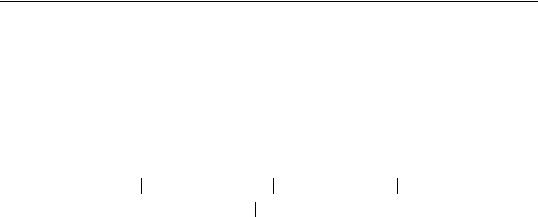
Binary Dependent Variable Models—249
where Fu is the cumulative distribution function of u . Common models include probit (standard normal), logit (logistic), and gompit (extreme value) specifications for the F function.
In principle, the coding of the two numerical values of y is not critical since each of the binary responses only represents an event. Nevertheless, EViews requires that you code y as a zero-one variable. This restriction yields a number of advantages. For one, coding the
variable in this fashion implies that expected value of y is simply the probability that y = 1 :
E(yi xi, b) = 1 Pr(yi = 1 xi, b) + 0 Pr(yi = 0 xi, b)
(26.7)
= Pr(yi = 1 xi, b).
This convention provides us with a second interpretation of the binary specification: as a conditional mean specification. It follows that we can write the binary model as a regression model:
|
|
|
|
yi = |
(1 – F(–xi¢b)) + ei , |
(26.8) |
where ei is a residual representing the deviation of the binary yi |
from its conditional mean. |
|||||
Then: |
|
|
||||
E(ei |
|
xi, b) = 0 |
(26.9) |
|||
|
||||||
var(ei |
|
xi, b) |
= F(–xi¢b)(1 – F(–xi¢b)). |
|||
|
|
|||||
We will use the conditional mean interpretation in our discussion of binary model residuals (see “Make Residual Series” on page 261).
Estimating Binary Models in EViews
To estimate a binary dependent variable model, choose Object/New Object… from the main menu and select the Equation object from the main menu. From the Equation Specification dialog, select the BINARY - Binary Choice (Logit, Probit, Extreme Value) estimation method. The dialog will change to reflect your choice. Alternately, enter the keyword binary in the command line and press ENTER.
There are two parts to the binary model specification. First, in the Equation Specification field, you may type the name of the binary dependent variable followed by a list of regressors or you may enter an explicit expression for the index. Next, select from among the three distributions for your error term:
Probit |
Pr(yi = 1 xi, b) = 1 – F(–xi¢b) = F(xi¢b) |
|
|
|
|
|
|
|
|
where F is the cumulative distribution function of the stan- |
|
|
dard normal distribution. |
|
|
|
|
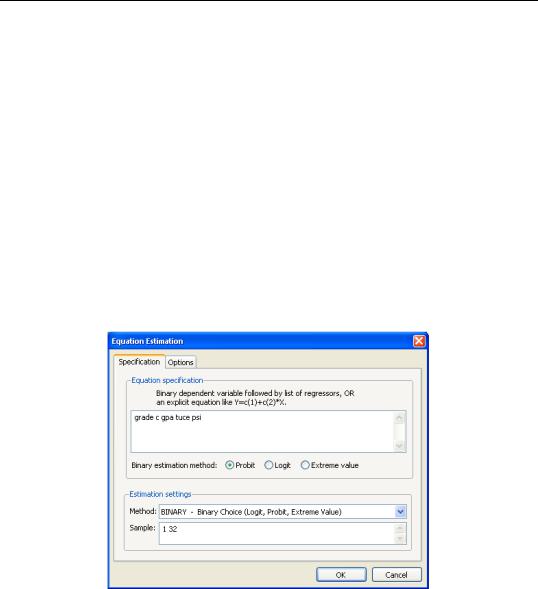
250—Chapter 26. Discrete and Limited Dependent Variable Models
Logit |
Pr(yi = 1 |
|
xi, b) |
= 1 – (e–xi ¢b § (1 + e–xi¢b )) |
|||||
|
|||||||||
|
|
|
|
|
|
= exi ¢b § (1 + exi¢b ) |
|
|
|
|
which is based upon the cumulative distribution function for |
||||||||
|
the logistic distribution. |
|
|
|
|
||||
|
|
|
|
|
|
|
|
|
|
Extreme value |
Pr(yi = 1 |
|
xi, b) |
= 1 – (1 – exp(–e |
–x |
¢b |
)) |
||
(Gompit) |
|
i |
|
||||||
|
|
|
|
||||||
|
|
|
|
|
|
= exp(–e–xi¢b ) |
|
|
|
|
which is based upon the CDF for the Type-I extreme value dis- |
||||||||
|
tribution. Note that this distribution is skewed. |
|
|
|
|||||
|
|
|
|
|
|
|
|
|
|
For example, consider the probit specification example described in Greene (2008, p. 781783) where we analyze the effectiveness of teaching methods on grades. The variable GRADE represents improvement on grades following exposure to the new teaching method PSI (the data are provided in the workfile “Binary.WF1”). Also controlling for alternative measures of knowledge (GPA and TUCE), we have the specification:
Once you have specified the model, click OK. EViews estimates the parameters of the model using iterative procedures, and will display information in the status line. EViews requires that the dependent variable be coded with the values zero-one with all other observations dropped from the estimation.
Following estimation, EViews displays results in the equation window. The top part of the estimation output is given by:

Binary Dependent Variable Models—251
Dependent Variable: GRADE |
|
|
|
|
Method: ML - Binary Probit (Quadratic hill climbing) |
|
|
||
Date: 08/11/09 |
Time: 14:26 |
|
|
|
Sample: 1 32 |
|
|
|
|
Included observations: 32 |
|
|
|
|
Convergence achieved after 5 iterations |
|
|
||
Covariance matrix computed using second derivatives |
|
|||
|
|
|
|
|
|
|
|
|
|
Variable |
Coefficient |
Std. Error |
z-Statistic |
Prob. |
|
|
|
|
|
|
|
|
|
|
C |
-7.452320 |
2.542472 |
-2.931131 |
0.0034 |
GPA |
1.625810 |
0.693882 |
2.343063 |
0.0191 |
TUCE |
0.051729 |
0.083890 |
0.616626 |
0.5375 |
PSI |
1.426332 |
0.595038 |
2.397045 |
0.0165 |
|
|
|
|
|
|
|
|
|
|
The header contains basic information regarding the estimation technique (ML for maximum likelihood) and the sample used in estimation, as well as information on the number of iterations required for convergence, and on the method used to compute the coefficient covariance matrix.
Displayed next are the coefficient estimates, asymptotic standard errors, z-statistics and corresponding p-values.
Interpretation of the coefficient values is complicated by the fact that estimated coefficients from a binary model cannot be interpreted as the marginal effect on the dependent variable. The marginal effect of xj on the conditional probability is given by:
∂E(yi |
xi, b) |
= f(–xi¢b)bj , |
|
------------------------------ |
(26.10) |
||
∂xij |
|
|
|
where f(x) = dF(x) § dx is the density function corresponding to F . Note that bj is weighted by a factor f that depends on the values of all of the regressors in x . The direction of the effect of a change in xj depends only on the sign of the bj coefficient. Positive values of bj imply that increasing xj will increase the probability of the response; negative values imply the opposite.
While marginal effects calculation is not provided as a built-in view or procedure, in “Forecast” on page 261, we show you how to use EViews to compute the marginal effects.
An alternative interpretation of the coefficients results from noting that the ratios of coefficients provide a measure of the relative changes in the probabilities:
bj |
= |
∂E(yi |
|
xi, b) § ∂xij |
|
|
||
|
|
|
||||||
---- |
--------------------------------------------- |
|
|
|
|
. |
(26.11) |
|
∂E(yi |
|
xi, b) § ∂xik |
||||||
bk |
|
|
|
|
||||
In addition to the summary statistics of the dependent variable, EViews also presents the following summary statistics:

252—Chapter 26. Discrete and Limited Dependent Variable Models
McFadden R-squared |
0.377478 |
Mean dependent var |
0.343750 |
S.D. dependent var |
0.482559 |
S.E. of regression |
0.386128 |
Akaike info criterion |
1.051175 |
Sum squared resid |
4.174660 |
Schwarz criterion |
1.234392 |
Log likelihood |
-12.81880 |
Hannan-Quinn criter. |
1.111907 |
Restr. log likelihood |
-20.59173 |
LR statistic |
15.54585 |
Avg. log likelihood |
-0.400588 |
Prob(LR statistic) |
0.001405 |
|
|
|
|
|
|
|
|
|
|
First, there are several familiar summary descriptive statistics: the mean and standard deviation of the dependent variable, standard error of the regression, and the sum of the squared residuals. The latter two measures are computed in the usual fashion using the ordinary residuals:
ei = |
yi – E(yi |
|
ˆ |
= |
yi – (1 |
ˆ |
(26.12) |
|
|||||||
|
xi, b) |
– F(–xi¢b)). |
Additionally, there are several likelihood based statistics:
• |
ˆ |
Log likelihood is the maximized value of the log likelihood function l(b). |
|
• |
ˆ |
Avg. log likelihood is the log likelihood l(b) divided by the number of observations |
n.
•Restr. log likelihood is the maximized log likelihood value, when all slope coeffi-
cients are restricted to zero, l(˜ ). Since the constant term is included, this specifica- b
tion is equivalent to estimating the unconditional mean probability of “success”.
• The LR statistic tests the joint null hypothesis that all slope coefficients except the
2(l(˜ ) l(ˆ ))
constant are zero and is computed as – b – b . This statistic, which is only reported when you include a constant in your specification, is used to test the overall significance of the model. The degrees of freedom is one less than the number of coefficients in the equation, which is the number of restrictions under test.
•Probability(LR stat) is the p-value of the LR test statistic. Under the null hypothesis, the LR test statistic is asymptotically distributed as a x2 variable, with degrees of free-
dom equal to the number of restrictions under test.
• McFadden R-squared is the likelihood ratio index computed as 1 |
ˆ |
˜ |
– l(b) § l(b), |
||
where l(˜ ) is the restricted log likelihood. As the name suggests, this is an analog to b
the R2 reported in linear regression models. It has the property that it always lies between zero and one.
•The various information criteria are detailed in Appendix D. “Information Criteria,” beginning on page 771. For additional discussion, see Grasa (1989).

Binary Dependent Variable Models—253
Estimation Options
The iteration limit and convergence criterion may be set in the usual fashion by clicking on the Options tab in the Equation Estimation dialog. In addition, there are options that are specific to binary models. These options are described below.
Robust Covariances
For binary dependent variable models, EViews allows you to estimate the standard errors using the default (inverse of the estimated information matrix), quasi-maximum likelihood (Huber/White) or generalized linear model (GLM) methods. See “Technical Notes” on page 296 for a discussion of these methods.
Click on the Options tab to bring up the settings, check the Robust Covariance box and select one of the two methods. When you estimate the binary model using this option, the header in the equation output will indicate the method used to compute the coefficient covariance matrix.
Starting Values
As with other estimation procedures, EViews allows you to specify starting values. In the options menu, select one of the items from the combo box. You can use the default EViews values, or you can choose a fraction of those values, zero coefficients, or user supplied values. To employ the latter, enter the coefficients in the C coefficient vector, and select User Supplied in the combo box.
The EViews default values are selected using a sophisticated algorithm that is specialized for each type of binary model. Unless there is a good reason to choose otherwise, we recommend that you use the default values.
Estimation Algorithm
By default, EViews uses quadratic hill-climbing to obtain parameter estimates. This algorithm uses the matrix of analytic second derivatives of the log likelihood in forming iteration updates and in computing the estimated covariance matrix of the coefficients.
If you wish, you can employ a different estimation algorithm: Newton-Raphson also employs second derivatives (without the diagonal weighting); BHHH uses first derivatives to determine both iteration updates and the covariance matrix estimates (see Appendix B. “Estimation and Solution Options,” on page 751). To employ one of these latter methods, click on Options in the Equation specification dialog box, and select the desired method.
Note that the estimation algorithm does influence the default method of computing coefficient covariances. See “Technical Notes” on page 296 for discussion.

254—Chapter 26. Discrete and Limited Dependent Variable Models
Estimation Problems
In general, estimation of binary models is quite straightforward, and you should experience little difficulty in obtaining parameter estimates. There are a few situations, however, where you may experience problems.
First, you may get the error message “Dependent variable has no variance.” This error means that there is no variation in the dependent variable (the variable is always one or zero for all valid observations). This error most often occurs when EViews excludes the entire sample of observations for which y takes values other than zero or one, leaving too few observations for estimation.
You should make certain to recode your data so that the binary indicators take the values zero and one. This requirement is not as restrictive at it may first seem, since the recoding may easily be done using auto-series. Suppose, for example, that you have data where y takes the values 1000 and 2000. You could then use the boolean auto-series, “y=1000”, or perhaps, “y<1500”, as your dependent variable.
Second, you may receive an error message of the form “[xxxx] perfectly predicts binary response [success/failure]”, where xxxx is a sample condition. This error occurs when one of the regressors contains a separating value for which all of the observations with values below the threshold are associated with a single binary response, and all of the values above the threshold are associated with the alternative response. In this circumstance, the method of maximum likelihood breaks down.
For example, if all values of the explanatory variable x > 0 are associated with y = 1 , then x is a perfect predictor of the dependent variable, and EViews will issue an error message and stop the estimation procedure.
The only solution to this problem is to remove the offending variable from your specification. Usually, the variable has been incorrectly entered in the model, as when a researcher includes a dummy variable that is identical to the dependent variable (for discussion, see Greene, 2008).
Thirdly, you may experience the error, “Non-positive likelihood value observed for observation [xxxx].” This error most commonly arises when the starting values for estimation are poor. The default EViews starting values should be adequate for most uses. You may wish to check the Options dialog to make certain that you are not using user specified starting values, or you may experiment with alternative user-specified values.
Lastly, the error message “Near-singular matrix” indicates that EViews was unable to invert the matrix required for iterative estimation. This will occur if the model is not identified. It may also occur if the current parameters are far from the true values. If you believe the latter to be the case, you may wish to experiment with starting values or the estimation algo-
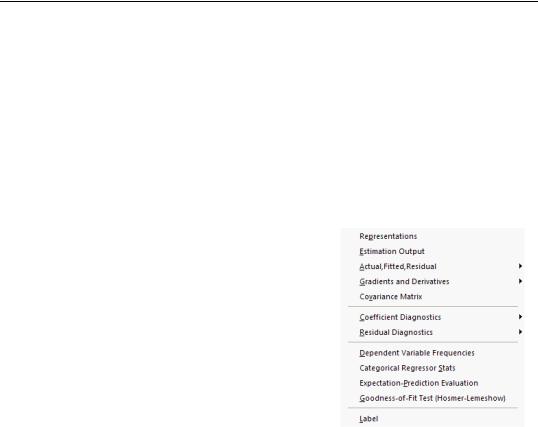
Binary Dependent Variable Models—255
rithm. The BHHH and quadratic hill-climbing algorithms are less sensitive to this particular problem than is Newton-Raphson.
Views of Binary Equations
EViews provides a number of standard views and procedures for binary models. For example, you can easily perform Wald or likelihood ratio tests by selecting View/Coefficient Diagnostics, and then choosing the appropriate test. In addition, EViews allows you to examine and perform tests using the residuals from your model. The ordinary residuals used in most calculations are described above—additional residual types are defined below. Note that some care should be taken in interpreting test statistics that use these residuals since some of the underlying test assumptions may not be valid in the current setting.
There are a number of additional specialized views and procedures which allow you to examine the properties and performance of your estimated binary model.
Dependent Variable Frequencies
This view displays a frequency and cumulative frequency table for the dependent variable in the binary model.
Categorical Regressor Stats
This view displays descriptive statistics (mean and standard deviation) for each regressor. The descrip-
tive statistics are computed for the whole sample, as well as the sample broken down by the value of the dependent variable y :

256—Chapter 26. Discrete and Limited Dependent Variable Models
Categorical Descriptive Statistics for Explanatory Variables
Equation: EQ_PROBIT
Date: 08/11/09 Time: 14:42
|
|
Mean |
|
Variable |
Dep=0 |
Dep=1 |
All |
|
|
|
|
|
|
|
|
C |
1.000000 |
1.000000 |
1.000000 |
GPA |
2.951905 |
3.432727 |
3.117188 |
TUCE |
21.09524 |
23.54545 |
21.93750 |
PSI |
0.285714 |
0.727273 |
0.437500 |
|
|
|
|
|
|
|
|
|
|
Standard |
|
|
|
Deviation |
|
Variable |
Dep=0 |
Dep=1 |
All |
|
|
|
|
|
|
|
|
C |
0.000000 |
0.000000 |
0.000000 |
GPA |
0.357220 |
0.503132 |
0.466713 |
TUCE |
3.780275 |
3.777926 |
3.901509 |
PSI |
0.462910 |
0.467099 |
0.504016 |
|
|
|
|
|
|
|
|
Observations |
21 |
11 |
32 |
|
|
|
|
|
|
|
|
Expectation-Prediction (Classification) Table
This view displays 2 ¥ 2 tables of correct and incorrect classification based on a user specified prediction rule, and on expected value calculations. Click on View/Expectation-Predic- tion Table. EViews opens a dialog prompting you to specify a prediction cutoff value, p , lying between zero and one. Each observation will be classified as having a predicted probability that lies above or below this cutoff.
After you enter the cutoff value and click on OK, EViews will display four (bordered) 2 ¥ 2 tables in the equation window. Each table corresponds to a contingency table of the predicted response classified against the observed dependent variable. The top two tables and associated statistics depict the classification results based upon the specified cutoff value:

Binary Dependent Variable Models—257
Expectation-Prediction Evaluation for Binary Specification
Equation: EQ_PROBIT
Date: 08/11/09 Time: 14:39
Success cutoff: C = 0.5
|
Estimated Equation |
Constant Probability |
||||
|
Dep=0 |
Dep=1 |
Total |
Dep=0 |
Dep=1 |
Total |
|
|
|
|
|
|
|
|
|
|
|
|
|
|
P(Dep=1)<=C |
18 |
3 |
21 |
21 |
11 |
32 |
P(Dep=1)>C |
3 |
8 |
11 |
0 |
0 |
0 |
Total |
21 |
11 |
32 |
21 |
11 |
32 |
Correct |
18 |
8 |
26 |
21 |
0 |
21 |
% Correct |
85.71 |
72.73 |
81.25 |
100.00 |
0.00 |
65.63 |
% Incorrect |
14.29 |
27.27 |
18.75 |
0.00 |
100.00 |
34.38 |
Total Gain* |
-14.29 |
72.73 |
15.63 |
|
|
|
Percent Gain** |
NA |
72.73 |
45.45 |
|
|
|
|
|
|
|
|
|
|
|
|
|
|
|
|
|
In the left-hand table, we classify observations as having predicted probabilities
ˆ |
ˆ |
|
= 1 – F(–xi¢b)that are above or below the specified cutoff value (here set to the |
||
pi |
default of 0.5). In the upper right-hand table, we classify observations using p , the sample proportion of y = 1 observations. This probability, which is constant across individuals, is the value computed from estimating a model that includes only the intercept term, C.
“Correct” classifications are obtained when the predicted probability is less than or equal to the cutoff and the observed y = 0 , or when the predicted probability is greater than the cutoff and the observed y = 1 . In the example above, 18 of the Dep=0 observations and 8 of the Dep=1 observations are correctly classified by the estimated model.
It is worth noting that in the statistics literature, what we term the expectation-prediction table is sometimes referred to as the classification table. The fraction of y = 1 observations that are correctly predicted is termed the sensitivity, while the fraction of y = 0 observations that are correctly predicted is known as specificity. In EViews, these two values, expressed in percentage terms, are labeled “% Correct”. Overall, the estimated model correctly predicts 81.25% of the observations (85.71% of the Dep=0 and 72.73% of the Dep=1 observations).
The gain in the number of correct predictions obtained in moving from the right table to the left table provides a measure of the predictive ability of your model. The gain measures are reported in both absolute percentage increases (Total Gain), and as a percentage of the incorrect classifications in the constant probability model (Percent Gain). In the example above, the restricted model predicts that all 21 individuals will have Dep=0. This prediction is correct for the 21 y = 0 observations, but is incorrect for the 11 y = 1 observations.
The estimated model improves on the Dep=1 predictions by 72.73 percentage points, but does more poorly on the Dep=0 predictions (-14.29 percentage points). Overall, the estimated equation is 15.62 percentage points better at predicting responses than the constant

258—Chapter 26. Discrete and Limited Dependent Variable Models
probability model. This change represents a 45.45 percent improvement over the 65.62 percent correct prediction of the default model.
The bottom portion of the equation window contains analogous prediction results based upon expected value calculations:
|
Estimated Equation |
Constant Probability |
||||
|
Dep=0 |
Dep=1 |
Total |
Dep=0 |
Dep=1 |
Total |
|
|
|
|
|
|
|
|
|
|
|
|
|
|
E(# of Dep=0) |
16.89 |
4.14 |
21.03 |
13.78 |
7.22 |
21.00 |
E(# of Dep=1) |
4.11 |
6.86 |
10.97 |
7.22 |
3.78 |
11.00 |
Total |
21.00 |
11.00 |
32.00 |
21.00 |
11.00 |
32.00 |
Correct |
16.89 |
6.86 |
23.74 |
13.78 |
3.78 |
17.56 |
% Correct |
80.42 |
62.32 |
74.20 |
65.63 |
34.38 |
54.88 |
% Incorrect |
19.58 |
37.68 |
25.80 |
34.38 |
65.63 |
45.12 |
Total Gain* |
14.80 |
27.95 |
19.32 |
|
|
|
Percent Gain** |
43.05 |
42.59 |
42.82 |
|
|
|
|
|
|
|
|
|
|
|
|
|
|
|
|
|
In the left-hand table, we compute the expected number of y = 0 and y |
= 1 observa- |
|||
tions in the sample. For example, E(# of Dep=0) is computed as: |
|
|||
ÂPr(yi = 0 |
|
xi, b) = |
ˆ |
(26.13) |
|
||||
|
ÂF(–xi¢b), |
|||
i |
|
|
i |
|
where the cumulative distribution function F is for the normal, logistic, or extreme value distribution.
In the lower right-hand table, we compute the expected number of y = 0 and y = 1 observations for a model estimated with only a constant. For this restricted model, E(# of Dep=0) is computed as n(1 – p), where p is the sample proportion of y = 1 observations. EViews also reports summary measures of the total gain and the percent (of the incorrect expectation) gain.
Among the 21 individuals with y = 0 , the expected number of y = 0 observations in the estimated model is 16.89. Among the 11 observations with y = 1 , the expected number of y = 1 observations is 6.86. These numbers represent roughly a 19.32 percentage point (42.82 percent) improvement over the constant probability model.
Goodness-of-Fit Tests
This view allows you to perform Pearson x2 -type tests of goodness-of-fit. EViews carries out two goodness-of-fit tests: Hosmer-Lemeshow (1989) and Andrews (1988a, 1988b). The idea underlying these tests is to compare the fitted expected values to the actual values by group. If these differences are “large”, we reject the model as providing an insufficient fit to the data.
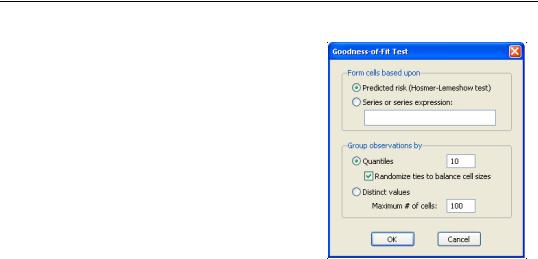
Binary Dependent Variable Models—259
Details on the two tests are described in the “Technical Notes” on page 296. Briefly, the tests differ in how the observations are grouped and in the asymptotic distribution of the test statistic. The Hosmer-Lemeshow test groups observations on the basis of the predicted probability that
y = 1 . The Andrews test is a more general test that groups observations on the basis of any series or series expression.
To carry out the test, select View/Goodness-of-Fit
Test…
You must first decide on the grouping variable. You can select Hosmer-Lemeshow (predicted
probability) grouping by clicking on the corresponding radio button, or you can select series grouping, and provide a series to be used in forming the groups.
Next, you need to specify the grouping rule. EViews allows you to group on the basis of either distinct values or quantiles of the grouping variable.
If your grouping variable takes relatively few distinct values, you should choose the Distinct values grouping. EViews will form a separate group for each distinct value of the grouping variable. For example, if your grouping variable is TUCE, EViews will create a group for each distinct TUCE value and compare the expected and actual numbers of y = 1 observations in each group. By default, EViews limits you to 100 distinct values. If the distinct values in your grouping series exceeds this value, EViews will return an error message. If you wish to evaluate the test for more than 100 values, you must explicitly increase the maximum number of distinct values.
If your grouping variable takes on a large number of distinct values, you should select Quantiles, and enter the number of desired bins in the edit field. If you select this method, EViews will group your observations into the number of specified bins, on the basis of the ordered values of the grouping series. For example, if you choose to group by TUCE, select Quantiles, and enter 10, EViews will form groups on the basis of TUCE deciles.
If you choose to group by quantiles and there are ties in the grouping variable, EViews may not be able to form the exact number of groups you specify unless tied values are assigned to different groups. Furthermore, the number of observations in each group may be very unbalanced. Selecting the randomize ties option randomly assigns ties to adjacent groups in order to balance the number of observations in each group.

260—Chapter 26. Discrete and Limited Dependent Variable Models
Since the properties of the test statistics require that the number of observations in each group is “large”, some care needs to be taken in selecting a rule so that you do not end up with a large number of cells, each containing small numbers of observations.
By default, EViews will perform the test using Hosmer-Lemeshow grouping. The default grouping method is to form deciles. The test result using the default specification is given by:
Goodness-of-Fit Evaluation for Binary Specification |
|
|
|
|||||
Andrews and Hosmer-Lemeshow Tests |
|
|
|
|
||||
Equation: EQ_PROBIT |
|
|
|
|
|
|
||
Date: 08/11/09 |
Time: 14:56 |
|
|
|
|
|
||
Grouping based upon predicted risk (randomize ties) |
|
|
|
|||||
|
|
|
|
|
|
|
|
|
|
|
|
|
|
|
|
|
|
|
Quantile of Risk |
|
Dep=0 |
|
Dep=1 |
Total |
H-L |
|
|
Low |
High |
Actual |
Expect |
Actual |
Expect |
Obs |
Value |
|
|
|
|
|
|
|
|
|
|
|
|
|
|
|
|
|
|
1 |
0.0161 |
0.0185 |
3 |
2.94722 |
0 |
0.05278 |
3 |
0.05372 |
2 |
0.0186 |
0.0272 |
3 |
2.93223 |
0 |
0.06777 |
3 |
0.06934 |
3 |
0.0309 |
0.0457 |
3 |
2.87888 |
0 |
0.12112 |
3 |
0.12621 |
4 |
0.0531 |
0.1088 |
3 |
2.77618 |
0 |
0.22382 |
3 |
0.24186 |
5 |
0.1235 |
0.1952 |
2 |
3.29779 |
2 |
0.70221 |
4 |
2.90924 |
6 |
0.2732 |
0.3287 |
3 |
2.07481 |
0 |
0.92519 |
3 |
1.33775 |
7 |
0.3563 |
0.5400 |
2 |
1.61497 |
1 |
1.38503 |
3 |
0.19883 |
8 |
0.5546 |
0.6424 |
1 |
1.20962 |
2 |
1.79038 |
3 |
0.06087 |
9 |
0.6572 |
0.8342 |
0 |
0.84550 |
3 |
2.15450 |
3 |
1.17730 |
10 |
0.8400 |
0.9522 |
1 |
0.45575 |
3 |
3.54425 |
4 |
0.73351 |
|
|
|
|
|
|
|
|
|
|
|
|
|
|
|
|
|
|
|
|
Total |
21 |
21.0330 |
11 |
10.9670 |
32 |
6.90863 |
|
|
|
|
|
|
|
||
|
|
|
|
|
|
|
||
H-L Statistic |
|
6.9086 |
|
Prob. Chi-Sq(8) |
0.5465 |
|
||
Andrews Statistic |
20.6045 |
|
Prob. Chi-Sq(10) |
0.0240 |
|
|||
|
|
|
|
|
|
|
|
|
|
|
|
|
|
|
|
|
|
The columns labeled “Quantiles of Risk” depict the high and low value of the predicted probability for each decile. Also depicted are the actual and expected number of observations in each group, as well as the contribution of each group to the overall Hosmer-Leme- show (H-L) statistic—large values indicate large differences between the actual and predicted values for that decile.
The x2 statistics are reported at the bottom of the table. Since grouping on the basis of the fitted values falls within the structure of an Andrews test, we report results for both the H-L and the Andrews test statistic. The p-value for the HL test is large while the value for the Andrews test statistic is small, providing mixed evidence of problems. Furthermore, the relatively small sample sizes suggest that caution is in order in interpreting the results.

Binary Dependent Variable Models—261
Procedures for Binary Equations
In addition to the usual procedures for equations, EViews allows you to forecast the dependent variable and linear index, or to compute a variety of residuals associated with the binary model.
Forecast
ˆ |
ˆ |
|
= 1 – F(–xi¢b), or the fit- |
||
EViews allows you to compute either the fitted probability, pi |
ted values of the index xi¢b . From the equation toolbar select Proc/Forecast (Fitted Probability/Index)…, and then click on the desired entry.
As with other estimators, you can select a forecast sample, and display a graph of the forecast. If your explanatory variables, xt , include lagged values of the binary dependent variable yt , forecasting with the Dynamic option instructs EViews to use the fitted values
pˆ t – 1 , to derive the forecasts, in contrast with the Static option, which uses the actual (lagged) yt – 1 .
Neither forecast evaluations nor automatic calculation of standard errors of the forecast are currently available for this estimation method. The latter can be computed using the variance matrix of the coefficients obtained by displaying the covariance matrix view using View/Covariance Matrix or using the @covariance member function.
You can use the fitted index in a variety of ways, for example, to compute the marginal effects of the explanatory variables. Simply forecast the fitted index and save the results in a series, say XB. Then the auto-series @dnorm(-xb), @dlogistic(-xb), or @dextreme(- xb) may be multiplied by the coefficients of interest to provide an estimate of the deriva-
tives of the expected value of yi with respect to the j-th variable in xi : |
|
||
∂E(yi |
xi, b) |
= f(–xi¢b)bj . |
|
------------------------------ |
(26.14) |
||
∂xij |
|
|
|
Make Residual Series
Proc/Make Residual Series gives you the option of generating one of the following three types of residuals:
Ordinary |
eoi |
= yi – pi |
|
||
|
|
|
|
ˆ |
|
Standardized |
|
|
yi – pi |
||
esi |
= |
|
|
ˆ |
|
|
---------------------------ˆ |
(1 |
ˆ - |
||
|
|
|
pi |
– pi) |
|
Generalized |
|
|
(yi |
– pi)f(–xi¢b) |
|
egi |
= |
|
ˆ |
ˆ |
|
|
---------------------------------------- |
ˆ |
- |
||
|
|
|
|
pi(1 – pi) |
|
|
|
|
|
|
ˆ |

262—Chapter 26. Discrete and Limited Dependent Variable Models
ˆ |
ˆ |
|
= 1 – F(–xi¢b) is the fitted probability, and the distribution and density func- |
||
where pi |
tions F and f , depend on the specified distribution.
The ordinary residuals have been described above. The standardized residuals are simply the ordinary residuals divided by an estimate of the theoretical standard deviation. The generalized residuals are derived from the first order conditions that define the ML estimates. The first order conditions may be regarded as an orthogonality condition between the generalized residuals and the regressors x .
∂l(b) |
= |
N (yi – (1 – F(–xi¢b)))f(–xi¢b) |
xi |
= |
N |
eg, i xi . |
(26.15) |
|
------------∂b - |
 |
------------------------------------------------------------------------- |
 |
|||||
|
F(–xi¢b)(1 – F(–xi¢b)) |
|
|
|
|
|||
|
|
i = 1 |
|
|
|
i = 1 |
|
|
This property is analogous to the orthogonality condition between the (ordinary) residuals and the regressors in linear regression models.
The usefulness of the generalized residuals derives from the fact that you can easily obtain the score vectors by multiplying the generalized residuals by each of the regressors in x . These scores can be used in a variety of LM specification tests (see Chesher, Lancaster and Irish (1985), and Gourieroux, Monfort, Renault, and Trognon (1987)). We provide an example below.
Demonstrations
You can easily use the results of a binary model in additional analysis. Here, we provide demonstrations of using EViews to plot a probability response curve and to test for heteroskedasticity in the residuals.
Plotting Probability Response Curves
You can use the estimated coefficients from a binary model to examine how the predicted probabilities vary with an independent variable. To do so, we will use the EViews built-in modeling features. (The following discussion skims over many of the useful features of EViews models. Those wishing greater detail should consult Chapter 34. “Models,” beginning on page 511.)
For the probit example above, suppose we are interested in the effect of teaching method (PSI) on educational improvement (GRADE). We wish to plot the fitted probabilities of GRADE improvement as a function of GPA for the two values of PSI, fixing the values of other variables at their sample means.
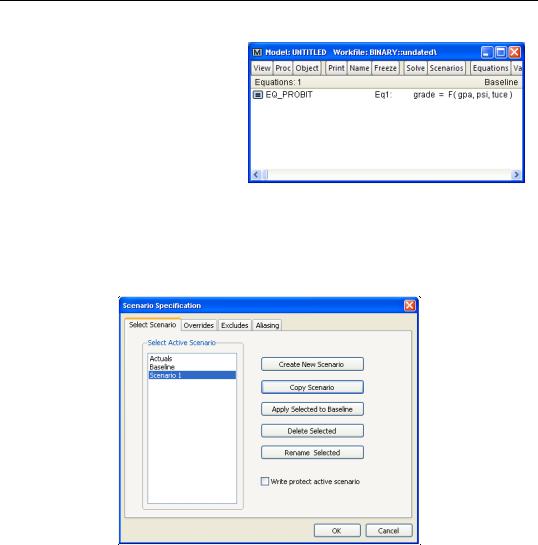
Binary Dependent Variable Models—263
First, we create a model out of the estimated equation by selecting
Proc/Make Model from the equation toolbar. EViews will create an untitled model object linked to the estimated equation and will open the model window.
What we will do is to use the model to solve for values of the
probabilities for various values of GPA, with TUCE equal to the mean value, and PSI equal to 0 in one case, and PSI equal to 1 in a second case. We will define scenarios in the model so that calculations are performed using the desired values. Click on the Scenarios button on the model toolbar to display the Scenario Specification dialog and click on Scenario 1 to define the settings for that scenario.
The Scenario Specification dialog allows us to define a set of assumptions under which we will solve the model. Click on the Overrides tab and enter “GPA PSI TUCE”. Defining these overrides tells EViews to use the values in the series GPA_1, PSI_1, and TUCE_1 instead of the original GPA, PSI, and TUCE when solving for GRADE under Scenario 1.
Having defined the first scenario, we must create the series GPA_1, PSI_1 and TUCE_1 in our workfile. We wish to use these series to evaluate the GRADE probabilities for various values of GPA holding TUCE equal to its mean value and PSI equal to 0.
First, we will use the command line to fill GPA_1 with a grid of values ranging from 2 to 4. The easiest way to do this is to use the @trend function:

264—Chapter 26. Discrete and Limited Dependent Variable Models
series gpa_1 = 2+(4-2)*@trend/(@obs(@trend)-1)
Recall that @trend creates a series that begins at 0 in the first observation of the sample, and increases by 1 for each subsequent observation, up through @obs-1.
Next we create series TUCE_1 containing the mean values of TUCE and a series PSI_1 which we set to zero:
series tuce_1 = @mean(tuce) series psi_1 = 0
Having prepared our data for the first scenario, we will now use the model object to define an alternate scenario where PSI=1. Return to the Select Scenario tab, select Copy Scenario, then select Scenario 1 as the Source, and New Scenario as the Destination. Copying Scenario 1 creates a new scenario, Scenario 2, that instructs EViews to use the values in the series GPA_2, PSI_2, and TUCE_2 when solving for GRADE. These values are initialized from the corresponding Scenario 1 series defined previously. We then set PSI_2 equal to 1 by issuing the command
psi_2 = 1
We are now ready to solve the model under the two scenarios. Click on the Solve button and set the Active solution scenario to Scenario 1 and the Alternate solution scenario to
Scenario 2. Be sure to click on the checkbox Solve for Alternate along with Active and calc deviations so that EViews knows to solve for both. You can safely ignore the remaining solution settings and simply click on OK.
EViews will report that your model has solved successfully and will place the solutions in the series GRADE_1 and GRADE_2, respectively. To display the results, select Object/New Object.../Group, and enter:
gpa_1 grade_1 grade_2
EViews will open an untitled group window containing these three series. Select View/ Graph/XY line to display a graph of the fitted GRADE probabilities plotted against GPA for those with PSI=0 (GRADE_1) and with PSI=1 (GRADE_2), both computed with TUCE evaluated at means.
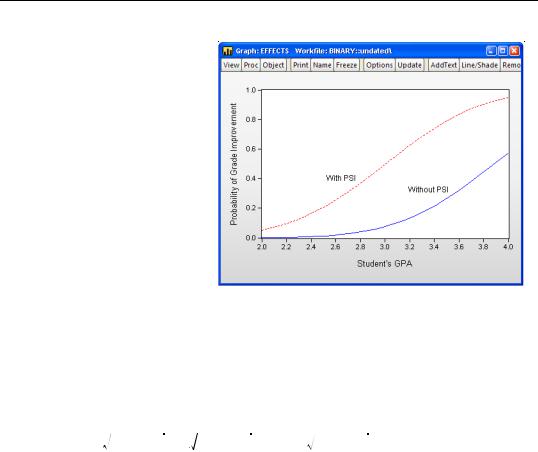
Binary Dependent Variable Models—265
We have annotated the graph slightly so that you can better judge the effect of the new teaching methods (PSI) on the probability of grade improvement for various values of the student’s GPA.
Testing for Heteroskedasticity
As an example of specification tests for binary dependent variable models, we carry out the LM test for heteroskedasticity using the artificial regression method
described by Davidson and MacKinnon (1993, section 15.4). We test the null hypothesis of homoskedasticity against the alternative of heteroskedasticity of the form:
var(ui) = exp(2zi¢g), |
(26.16) |
where g is an unknown parameter. In this example, we take PSI as the only variable in z .
The test statistic is the explained sum of squares from the regression: |
|
|||||||||
(yi – pi) |
|
f(–xi¢b) |
|
f(–xi¢b)(–xi |
¢b) |
|
|
|
||
ˆ |
= |
|
ˆ |
xi¢b1 + |
ˆ |
|
ˆ |
zi¢b2 |
+ vi , |
|
|
ˆ |
ˆ - |
-------------------------------------- |
(26.17) |
||||||
---------------------------pˆ i(1 – pˆ i) |
ˆ |
ˆ |
|
|||||||
|
pi(1 |
– pi) |
|
pi(1 |
– pi) |
|
|
|
||
which is asymptotically distributed as a x2 with degrees of freedom equal to the number of variables in z (in this case 1).
To carry out the test, we first retrieve the fitted probabilities pˆ i and fitted index xi¢b . Click on the Forecast button and first save the fitted probabilities as P_HAT and then the index as XB (you will have to click Forecast twice to save the two series).
Next, the dependent variable in the test regression may be obtained as the standardized residual. Select Proc/Make Residual Series… and select Standardized Residual. We will save the series as BRMR_Y.
Lastly, we will use the built-in EViews functions for evaluating the normal density and cumulative distribution function to create a group object containing the independent variables:
series fac=@dnorm(-xb)/@sqrt(p_hat*(1-p_hat)) group brmr_x fac (gpa*fac) (tuce*fac) (psi*fac)
